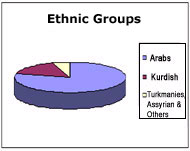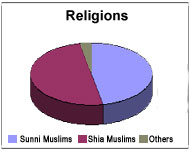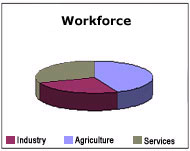Iraq: Country profile
Iraq is home to several ethnicities and sects. The Arab Muslim majority accounts for around 77.1% of the whole population. Kurds constitute 19% and the rest represents other minorities including Assyrians, Armenians, Azerbaijanis and Turkmen.

General facts:
Official name: Republic of Iraq
Form of government: republic with one legislative house (National Assembly – 220 seats)
Term of citizens: Iraqis
Monetary unit: Iraqi Dinar = 1000 fils
Capital: Baghdad
Official religion: Islam
Official language: Arabic. Kurdish is a formal language in the Kurdish autonomous region.
Administrative divisions: 18 governorates; Al Anbar, Al Basra, Al Muthanna, Al-Qadissiya, Al Najaf, Irbil, Al Sulaimaniya, Al Amim, Babil, Baghdad, Dahuk, Thee Qar, Diyala, Karbala, Maysan, Ninawa, Salah al-Deen, Wasit.
Demography and vital statistics:
 |
Population: 24.001.816 (2002 est.)
Age categorisation:
– 0-14 years: 41.1%
– 15-64 years: 55.9%
– 65 years and over: 3% (2002 est.)
Doubling time: 29 years
Natural increase rate per 1,000 population: (1994): 24.3 (world average 16.8).
Major causes of death: Prior to the UN sanctions 1990: circulatory diseases, cancer, and congenital anomalies. Since 1990 additional death reasons appeared because of lack of medical care and malnutrition resulting from UN-imposed sanctions.
 |
Ethnic structure:
– Arabs: 77.1%
– Kurd: 19%
– Assyrian: 0.8%
– Other: 3.1%
 |
Religious composition:
– Muslims: 97%, divided almost equally between Sunnis and Shias.
– Christians: 2.7%
– Jews, Yazidi and others: 0.3%
Major cities: Baghdad, Mosul, and Al Basra
Geography:
Location: Middle East
Bordering countries: Iran, Jordan, Kuwait, Saudi Arabia, Syria, and Turkey.
Total area: 437.072 sq. km.
Land area: 432.162 sq. km.
Water area: 4.910 sq. km.
Climate: Desert, with cool winters and hot, dry summers.
Terrain: Alluvial plains, mountains and deserts.
Note: Iraq has a strategic location in the Middle East and at the head of the Arab Gulf.
 |
Economy:
Iraq’s economy is dominated by the oil sector.
– GDP: $ 59 billion (2001 est.)
– Agriculture: 6%
– Industry: 13%
– Services: 81%
Annual growth rate: 5.7% (2001 est.)
Inflation rate: 60% (2001 est.)
Labour force: 6.5 million (2002 est.)
Unemployment rate: Not Available
Products:
– Industries: Petroleum, chemicals, textiles, electronics and construction materials.
– Agriculture: Wheat, barley, rice, cotton, dates, poultry and vegetables.
Natural resources: Oil, natural gas, phosphates and sulphur
Exports: $15.8 billion (2001 est.)
Imports: $11 billion (2001 est.)
Military:
Total active duty personnel (1997) 387,500 (army 90.3%, navy 0.7%, air force 9.0%). Estimated military expenditure as percentage of gross domestic product (1994) 18%.
Communications:
Telephones: 675.000 (1997 est.)
Radios: 4.85 million (1997 est.)
Televisions: 1.75 million (1997 est.)
Internet service providers: 1
Background:
– In the Middle Ages, Iraq was the centre of an Islamic Empire.
– The modern Kingdom of Iraq achieved full independence from the British Mandate in 1932.
– In 1958 the monarchy was abolished and Iraq was proclaimed a republic with Abd al-Karim Qassim as Iraq’s first president.
– In 1979 Saddam Hussein became President.
– In 1980 Iraq was plunged into an eight-year, bloody war with Iran.
– In 1990 Iraq invaded Kuwait, to be expelled in 1991 by a coalition of 33 countries.Subsequently sanctions were imposed on Iraq.
– In April 2003, the fall of the ruling Ba’ath Party by US-led forces after a 21-day US-led war to topple Saddam Hussein.
Go back: Special Report